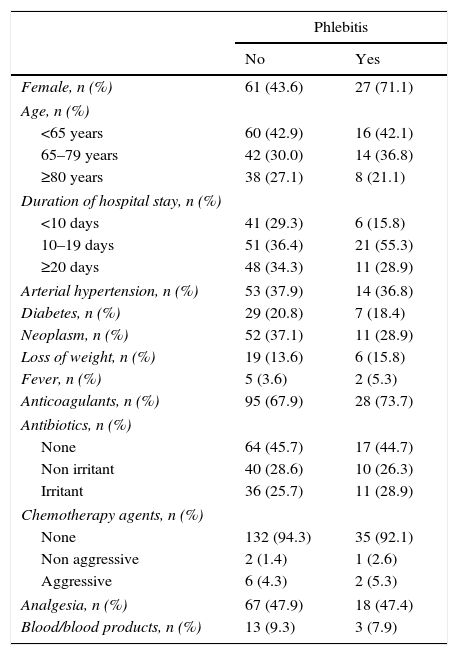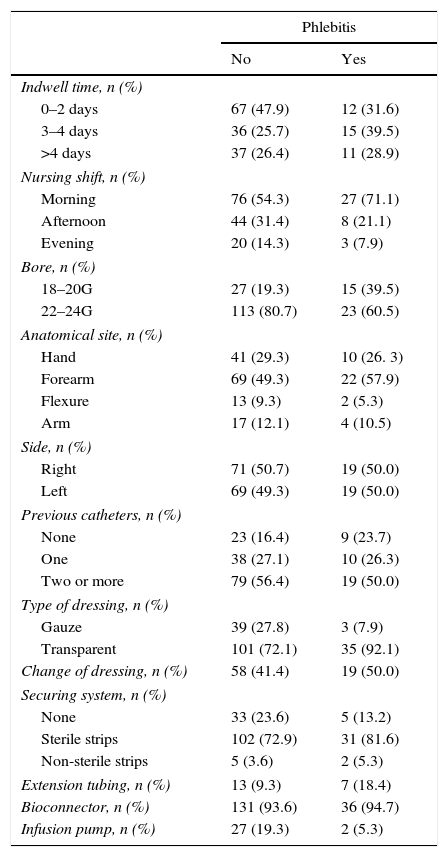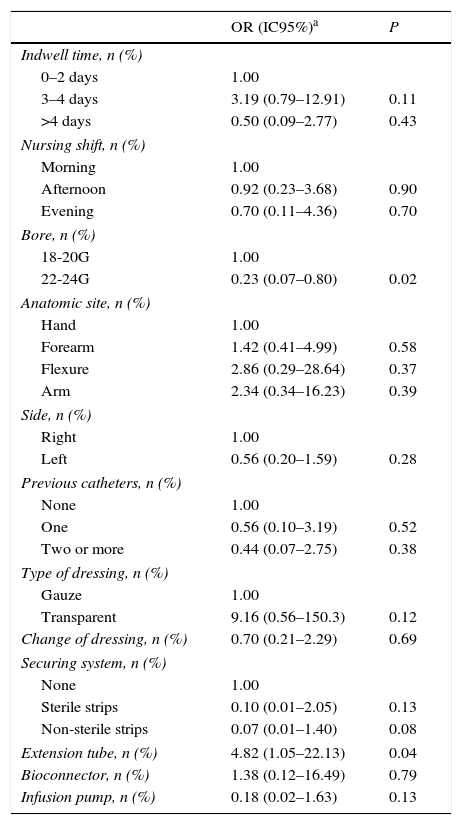To determine the incidence and risk factors of phlebitis associated to the care of peripheral vascular catheters (PVC).
MethodProspective cohort study at the Central University Hospital of Asturias (Spain). A total of 178 PVC were observed daily until their extraction. The incidence of phlebitis was measured using the visual infusion phlebitis scale, that distinguishes between grade I (possible phlebitis) and II (phlebitis). The independent diagnoses of phlebitis made by staff nurses were also collected. Finally, data about the insertion and the care of the PVC was also obtained. The incidence of phlebitis and the validity of the diagnoses made by staff nurses were calculated and the risk factors of phlebitis were determined by means of logistic regression.
Results5.6% of the PVC presented phlebitis, 21.3% possible phlebitis and 11.2% had phlebitis according to nurses’ criteria. The staff nurses had a sensitivity of 100%, a specificity of 94% and a positive predictive value of 50% in the diagnosis of phlebitis. After adjusting for potential confounders, the use of an extension tube as an accessory of the PVC was an independent predictor of phlebitis (odds ratio: 4.8; P=0.04), but a PVC size of 22/24 gauges was associated with lower phlebitis incidence (odds ratio: 0.2; P=0.02).
ConclusionsClinical phlebitis assessment is difficult because the agreement for phlebitis diagnosis is low. To minimise the incidence of phlebitis would be recommended to choose the smallest PVC size possible and to avoid using an extension tube as an accessory of the PVC.
Determinar la incidencia de flebitis y los factores de riesgo relacionados con el cuidado de los catéteres venosos periféricos (CVP).
MétodoEstudio de cohortes prospectivo en el Hospital Universitario Central de Asturias. Se incluyeron 178CVP que fueron observados diariamente hasta su retirada. La ocurrencia de flebitis fue medida con la escala visual de flebitis por infusión, que permite distinguir entre grado i (posible flebitis) y grado ii (flebitis). También se recogió el diagnóstico de flebitis que realizó de forma independiente el personal de enfermería de las unidades. Por último, se obtuvo información sobre la inserción y el cuidado del CVP. Se calculó la incidencia de flebitis y la validez de los diagnósticos realizados en la unidad y, mediante regresión logística, se identificaron los factores de riesgo de flebitis.
ResultadosEl 5,6% de los CVP presentaron flebitis, el 21,3% posibles flebitis y el 11,2% flebitis según el criterio del personal enfermero. La sensibilidad de los profesionales para diagnosticar flebitis fue del 100%, la especificidad, del 94%, y el valor predictivo positivo, del 50%. Después de controlar los potenciales confusores, la utilización de alargadera como accesorio del CVP incrementó el riesgo de flebitis (odds ratio: 4,8; p=0,04) e insertar un catéter de calibre 22/24 gauges lo disminuyó (odds ratio: 0,2; p=0,02).
ConclusionesLa falta de consenso sobre el diagnóstico de la flebitis dificulta su valoración por parte de los profesionales. Para minimizar la incidencia de flebitis sería aconsejable elegir el calibre de CVP más pequeño posible y evitar el uso de alargaderas como accesorio.
Artículo
Comprando el artículo el PDF del mismo podrá ser descargado
Precio 19,34 €
Comprar ahora










